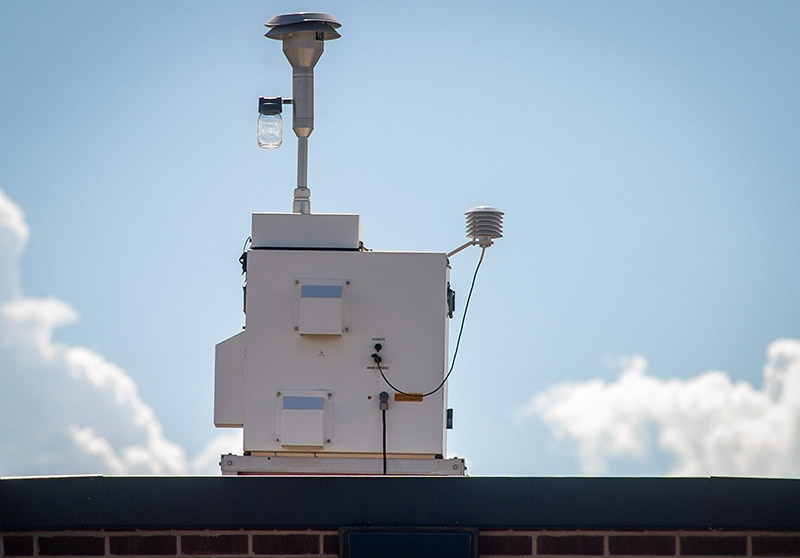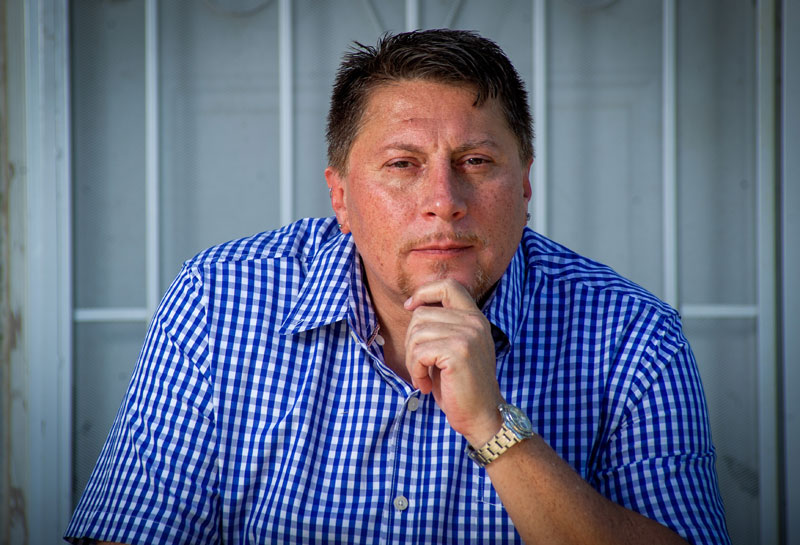
The Comanche Generating Station dominates the Pueblo, Colo. skyline in many directions. Photos by Mike Sweeney / Special to The Colorado Trust
The Comanche Generating Station dominates the Pueblo, Colo. skyline in many directions. Photos by Mike Sweeney / Special to The Colorado Trust
Five-hundred-foot smokestacks that define the Comanche Generating Station on Pueblo’s southeast side are a testament to this steel town’s industrial legacy.
Visible for miles, the vertical pipes are also a stark reminder to the city’s 112,000 residents how little they know about pollution produced by Colorado’s biggest coal-fired power plant and if it contributes to chronic health problems.
The Xcel Energy facility, slated to close by 2031, emits more toxic air contaminants than any other source in the city and is the state’s largest greenhouse gas producer, which adds to pollution that fouls air along the Front Range.
Pueblo suffers higher rates of respiratory ailments and cancer than state averages, particularly in communities of color near Comanche. In 2020, city residents visited the emergency department for asthma and chronic obstructive pulmonary disease at a much higher rate than the state average, statistics show.
“See those stacks?” Velma Campbell, MD, a physician who specializes in public health, asked on a recent warm day as she stood at a fence line south of the Comanche plant and pointed at the gray, white and red banded pipes. “You will hear it’s mostly steam coming from them, but contained in that plume are hundreds to thousands of pounds of toxic pollutants.
“Our air is a dumping ground.”

Dr. Velma Campbell, photographed in Pueblo in July 2022.
Campbell pointed to the Environmental Protection Agency (EPA) Toxics Release Inventory, which showed that the Comanche plant emitted more than one million pounds of toxic chemicals in 2020. These emissions made it responsible for about two thirds of the region’s toxic chemical pollution, inventory statistics show. Campbell—together with people like Jamie Valdez, a community organizer for Mothers Out Front, a national social, racial and environmental justice nonprofit—have worked for decades to persuade lawmakers to better measure pollution in Pueblo.
When asked how the planned retirement of two of the three generators at Comanche might impact emissions, Michelle Aguayo, an Xcel spokesperson, pointed to a 2021 sustainability report. When units 1 and 2 shut down in 2022 and 2025, respectively, sulfur dioxide emissions are projected to fall by half; nitrogen oxides by almost 70%; and mercury and particulate matter by about 40%, compared to 2021 levels, the report found. (The third and final generating unit at Comanche is set to close in or by 2031.)
Steam produced by burning coal at the Comanche plant powers a massive furnace at Evraz Rocky Mountain Steel, which forged much of the iron that built the West.
The hulking 141-year-old pipe mill sits about five miles northwest of the generating station and sends a variety of pollutants—many of which have documented adverse health effects—into Pueblo neighborhoods, including Salt Creek and Bessemer, documents filed with the federal government show. People of color comprise more than half of the population here, twice as high as the state average.
EPA reports show several chemicals released by the mill are “known to be a human carcinogen.” Other industrial polluters contribute to the invisible toxic stew in the city’s air, including Goodrich Corporation—now part of Collins Aerospace—a transportation equipment manufacturer in the northeastern part of the city, EPA data shows.
Under permits issued by the Colorado Department of Public Health and Environment (CDPHE) Air Pollution Control Division, the companies that operate the power plant, the mill and the transportation parts manufacturer are required to monitor and report emissions several times a year. These permits set limits for certain compounds facilities can emit annually.
Such self-reported statistics are unreliable and do not provide a complete picture of cumulative impacts, said Rebecca Curry, Colorado policy counsel for the environmental nonprofit Earthjustice. Emissions are submitted in tons, which makes it difficult to discern how such pollution might impact residents, she added.
Long-standing gaps in data about what’s in the air they breathe leave people across Colorado without the ability to hold officials and companies accountable for properly monitoring and mitigating pollution. Disproportionately impacted community members are often left out of conversations about how pollution impacts their families’ health.
Despite having documented sources of air pollution all over Pueblo, as well as disproportionate health outcomes that have elsewhere been linked to air pollution, there’s basically no sense as to what Pueblo’s air quality is at present. That’s about to change.
Quantifying Environmental Justice
Puebloans are at the forefront of an emerging partnership between activists, conservationists and a newly created state unit to quantify environmental justice hotspots in communities and the toxic pollutants that bedevil them.
The partnership represents a dramatic shift from federal regulation of air toxins—which relies on self-reported data from companies—to the state. A suite of new laws signed by Gov. Jared Polis since 2020 require state officials to collect more detailed statistics on air toxins and devise a system to regulate them.
“In the next six years, we will see a vast increase in monitoring for air toxics in Colorado, where we’ve been relying on facility-reported data that doesn’t tell us concentrations anyone is breathing at one period of time,” Curry said.
“The federal government set health guidelines for air toxics and they are really not enforceable,” Curry added, saying a 2022 law, signed by Polis in June, “clearly states the state needs to act more stringently than the Environmental Protection Agency.”
Officials will do so by setting enforceable thresholds for individual pollutants. At least six monitors will be installed throughout Colorado to measure about 62 toxic air contaminants, according to the law. (Today, one air toxics monitor exists in the entire state—in Grand Junction, where it samples for 20 chemicals.) The state has not yet determined exactly where the new monitors will be placed.
The work is occurring in tandem with an effort by the Biden Administration to account for cumulative impacts of pollution on low-income communities of color that have borne the brunt of the poisonous fallout from American’s industrial revolution.
Living near a power plant is “correlated to greater adverse health outcomes,” researchers found in a July report in the journal PLOS ONE. In addition, exposure to toxic pollutants released by industrial operations is “inequitably distributed by class and race,” according to a 2019 study in GeoHealth.
In Colorado, the first step was to create a mapping tool to pinpoint communities at risk of exposure to high pollution levels. Federal screening systems don’t incorporate information specific to the state and its residents, said Joel Minor, environmental justice program manager at the Colorado Department of Public Health and Environment (CDPHE).
The recently unveiled database, known as EnviroScreen, shows what many Puebloans live every day: They face higher environmental health risks than other Coloradans.
Citizen Scientists
Incomplete data quantifying ozone and particle pollution left the American Lung Association unable to rank Pueblo County’s air quality in its 2022 State of the Air report, which found “137 million Americans are exposed to unhealthy levels of air pollution.”
One state monitor exists in the city, at Fountain Elementary School about six miles north of Comanche, three miles northeast of the steel mill and six miles west of the Goodrich facility. It points at a vexing conundrum for health officials: Only measuring for particulate matter in the air in one place, the monitor routinely shows that Pueblo has some of the cleanest air in the state. But the monitor is not checking for toxic air contaminants, ozone or other chemicals harmful to human health.

The air quality monitor at Fountain Elementary School in Pueblo.
“We have big chunks of missing data,” said Aaron Martinez, a program manager at the Pueblo Department of Public Health and Environment who also sits on the state’s Environmental Justice Advisory Board. “And, we have higher asthma and chronic obstructive pulmonary disease numbers than the rest of the state.”
“Until we have more monitors and data, we don’t have enough information to formulate a hypothesis about what’s contributing to this,” he added. “When you look at the numbers we have, it looks good.”
State officials hope to start filling in this missing data in the next two years, when they deploy new monitoring equipment to measure air toxics in Pueblo’s air, particularly in neighborhoods around the Goodrich plant.
The effort is mandated under a 2021 law that requires the company, as well as three others in north Denver, to install monitors on their fence line to calculate air toxics emissions. These systems are designed to identify potential leaks or spikes in harmful chemicals that could impact residents.
A newly created air toxics unit at CDPHE is purchasing mobile monitoring equipment and working with residents to map out where laboratory vans will sample air.
“We can drive anywhere on public roads—the air doesn’t just stay in nice little circles,” said Dan Bon, the air toxics measurement unit supervisor, at an Aug. 16 virtual Air Pollution Control Division meeting.
“We are looking at driving outside of those circles and moving around through the area,” Bon added, saying 83 facilities permitted to emit toxins are within 10 miles of Goodrich. Routes will be mapped according to wind conditions and disproportionately impacted community boundaries in EnviroScreen, he said.
Bon collected information from community members like Campbell about where to best circulate the vans, and install new monitors, in communities around the Goodrich plant and north Denver facilities.
Ground-based monitoring systems will be placed at three sites within three miles of the Goodrich facility. Eventually, data from this effort will be available in a centralized repository to be developed after a series of meetings with community members, said Michael Ogletree, director of the Air Pollution Control Division.
Valdez, of Mothers Out Front, told Bon at the meeting in August that the nonprofit created a “Clean Air Pueblo” team to develop a community-based monitoring network and “would love to partner as much as possible with you.”
“Our focus is to bring improved air quality monitoring to the Pueblo community, because right now to say our air quality monitoring is inadequate would be a major understatement—it’s nearly nonexistent,” said Valdez in an interview.

Jamie Valdez, photographed in Pueblo in July 2022.
The team plans to apply for a grant to purchase six monitors to start, working up to a dozen. Some businesses and nonprofits volunteered their property to install and collect data from monitors, Valdez said.
Valdez is a member of the state’s Environmental Justice Action Task Force. Created by another 2021 law, the 27-member body is mandated with creating a statewide plan with an emphasis on addressing “data gaps.”
Valdez and Campbell agree that even though they cannot definitively prove air toxins are causing respiratory health issues, available data shows a correlation between breathing problems and pollution from industrial sources.
“I grew up on the east side [of Pueblo] and I dealt with childhood asthma,” Valdez said during a recent conversation outside a coffee shop in the city’s downtown. “The impact radius of the Comanche plant is 12 miles and the Pueblo city limits are only 11 miles,” he said, citing data from the Clean Air Task Force, a national environmental nonprofit.
Campbell nodded in agreement and replied to Valdez: “I know I can tell when we’re having a bad air day—and so can you.”
Related Story: Colorado Towns are Taking Air Quality Monitoring into Their Own Hands